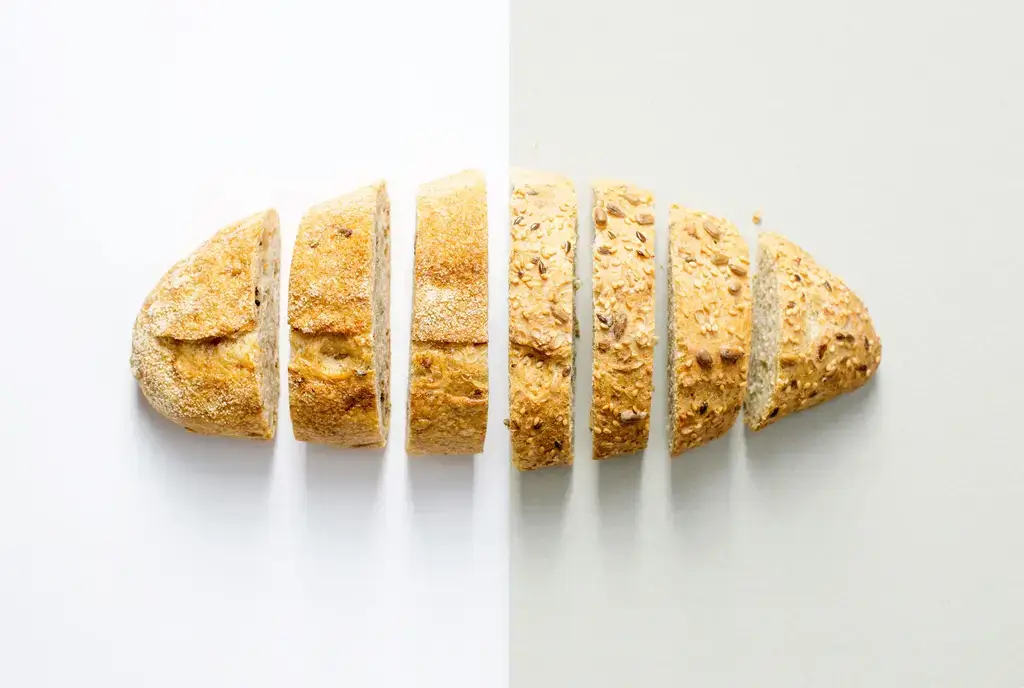Physical Address
304 North Cardinal St.
Dorchester Center, MA 02124
Physical Address
304 North Cardinal St.
Dorchester Center, MA 02124

Bread is a staple food that was first prepared and consumed as far back as the Neolithic period. The first bread was baked approximately 12,000 years ago in ancient Egypt, likely through a trial-and-error method while experimenting with water and flour.
The whole grain of cereals, including wheat, consists of the endosperm, bran (husk), and germ.
The bran (husk) is rich in non-starchy polysaccharides, known as dietary fibers, mainly arabinoxylans, followed by cellulose and beta-glucan. The germ is a source of unsaturated fats, Vitamin E, proteins, and B vitamins. The endosperm is rich in energy and consists of the starchy endosperm and the outer aleurone layer, which is rich in proteins.
Milling separates the from the and . This makes grinding into flour . The milling process often the , too. Complete refinement of the whole grain yields the . This product is commercially known as . It tastes great, but $\mathbfloses}$ much of its .
Bread Today
Bread is today’s most common . We make it from . These are , , , and . Production involves . They are , , , and .
n of white bread, you find about of carbs. It also has of fat and of protein. This equals roughly kilocalories. or seeded bread is better. It is more . These breads have more protein and . They are rich in , , and . This is an advantage over white or semi-white bread.
Sourdough bread is more nutritious. Its improves . Minerals are often bound by . This forms , an antinutrient complex. Phytates reduce how available minerals are. This complex hinders digestion and absorption. Sourdough helps overcome this issue.
Does Bread Make You Fat?
For many years, it has been a general belief that bread causes weight gain, consequently encouraging many people, directly or indirectly, to restrict or eliminate bread from their diet. For example, the consumption of bread, which is a part of the traditional Spanish (Mediterranean) diet, has begun to decline, as in the rest of the world. Although bread consumption has been falling for the last few decades, the “global epidemic” of obesity is on the rise. Maybe it’s not the bread after all?
No single food makes you fat. What causes weight gain, or an increase in body mass over a period of time, is an energy surplus. In translation, if a person continuously consumes more energy from food than they expend through their daily life, they will be in an energy surplus and their body mass will increase. This is true regardless of the food choices they consume.
However, we won’t deceive ourselves: the highly desirable taste, high glycemic index, and relatively high energy density of bread can very easily lead to the consumption of larger amounts of calories than we truly need at that moment. If this dietary situation occurs frequently, it logically increases the risk of a caloric surplus and, consequently, weight gain.
It is also vital to remember that we almost always with . The range of foods that pair well with bread is . Some of these have a high energy density, such as peanut butter, processed meats, jams, and the like.
Can’t Bread Be Part of a Healthy Diet?
Objectively, white bread is not a nutritionally rich food; it is poor in vitamins, fiber, and minerals. However, even as such, it can be part of a healthy diet. The role of food in the context of healthy eating is not only to satisfy physiological needs but also psychological ones, and even to shape social life, culture, and religion.
We don’t recommend much white bread for most people. However, it helps , especially post-workout. Bread has a . This means its starch breaks down fast into . Your body quickly absorbs this glucose. It goes from your small intestine right into your . This ultimately results in the fast replenishment of the previously emptied carbohydrate reservoir, known as glycogen. The faster glycogen is replenished, the faster the athlete will recover.
Should We Prefer Whole-Grain Bread?
Generally, when choosing between white and whole-grain bread (rye, buckwheat, oat, etc.), whole-grain bread is preferred. It is significantly richer nutritionally and can definitely be a major player in achieving a healthy diet. It is a source of significant amounts of dietary fiber, Vitamin E, B vitamins, minerals such as iron, zinc, phosphorus, selenium, and bioactive components.
Unlike white bread, which has a high glycemic index (meaning it causes a rapid rise and fall in blood sugar, resulting in the need for additional food intake even though the body does not need energy), whole-grain bread has a lower glycemic index and is a more stable energy source.
What Does Research Say?
Most studies that compared the effect of consuming white bread and whole-grain bread on body mass and abdominal fat tissue did not prove a significant association between the frequent consumption of white bread and an increase in body mass.
However, the same studies almost “unanimously” confirmed that dietary patterns dominated by whole-grain bread consumption over white bread show a better effect on controlling body mass and abdominal fat tissue compared to the reverse case.
Conclusion
If you are indeed eating large amounts of white bread and cannot reduce or control your food intake of bread, then eliminating white bread may be justified (though not necessary) for the purpose of easier self-control of body mass and the promotion of better health.